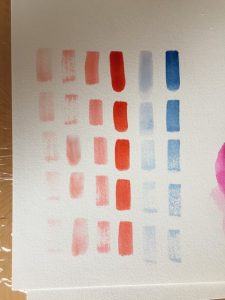In a slightly different approach than initially decided upon, in consideration of the restraints both my time and patience has on the actual piece itself, I opted to work in watercolour and ink as a means to produce multiple craft pieces while still exploring a similar concept. I diverged from the idea of a contemporary theme made in an older medium, and became more interested in attempting to achieve the same outcome visually across both a traditional and digital medium.
Digital tools such as Photoshop and Illustrator has allowed creatives to meet and exceed the limitations of traditional art for almost 27 years since it’s release in 1990. Outside of what the software offers in terms of tools, the platform allows for personally created tools such as brushes and overlay textures to expand the toolkit of the user. I wanted to see if I could create a series of both digital and traditional watercolour pieces, and attempt to make the digital pieces indistinguishable from the traditional ones. While I have seen extremely talented digital artists do this, doing this myself as still a student of digital art and manipulation would either confirm or contradict the perception that Photoshop is capable of just about anything, and the consequences this has for the digital medium and the traditional practitioners.
I began by downloading some independently made Photoshop brushes and a texture overlay, and began exploring with the opacity and pen pressure to determine the intensity of the strokes. I found that the brushes I had found (and what seems like the rest of the watercolour brushes available on the internet) were more similar to stamps of a watercolour splatter than an actual brush stroke, as when I make a stroke it made a repeat of the image rather than a line with a watercolour quality. I downloaded another program called FireAlpaca that enabled modification and the creation of new brushes that allowed for directed strokes. The manipulation tools made it easier to replicate a realistic brush, and even let me use blending tools and advanced opacity settings to make the strokes look flooded with water.
When I started on the traditional watercolour pieces, I found that planning in advance was more thought consuming than digitally. In software, any choice can easily be reversed or manipulated, but traditional – and watercolour especially – everything is permanent, and in this case cannot be erased and layering of each addition must be considered due to the opacity go the water. I experimented a bit with some masking fluid to block out some areas to prevent the layering of each addition, and realised that traditional watercolour is a balance of working quickly and slowly; in some areas I had to work quickly to make sure that the water or pigment didn’t spread too quickly and bleed into other areas, and I had to have patience as the masking fluid dried before I could continue, making the work a bit stop-start. At this stage, I’m not sure if I will be able to achieve a realistic looking digital piece, but so far attempting a reproduction of the process and medium has raised questions about the authenticity of each method and the value that comes from the medium, and does the existence of one decrease the value of the other.
- Water absorption test
- Mixing through water
- Traditional tools and mediums
- Water opacity test
- Salt texture sample
- My assistant assessing the quality of the brushes







Leave a Reply